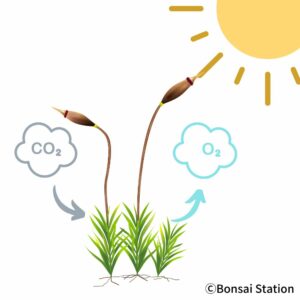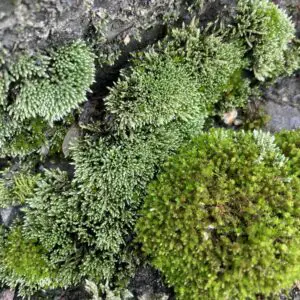Bonsai moss selection
Encouraging the healthy growth of bonsai moss begins with the selection of the moss. Not any moss can be a good bonsai moss. Because bonsai moss grows together with a bonsai tree, it needs to meet certain criteria (1) to look good with bonsai and (2) to grow healthy as a moss.
The best bonsai moss I recommend is silver moss (Bryum argenteum) and other moss in the Bryum family because;
- they are short and their color matches bonsai trees;
- they grow together densely and hold water and soil well;
- they can tolerate heat and cold;
- they grow well under the sunlight;
- they can be found anywhere near human habitat for free; and
- they do not need special care besides the bonsai tree.
To know more about whether any moss can be used for bonsai moss and the best bonsai moss species, please read the following posts.
“Can any moss be used for bonsai?” (Link here)
How to encourage bonsai moss
Just like an ordinary plant, a bonsai moss needs sunlight, humidity, temperature, CO2, nutrients and soil to grow healthy. This means that the environment necessary for a bonsai moss is not much different from the one for a bonsai tree.
Sunlight

Generally speaking, mosses are adapted to low light relative to other land plants. Because the leaf structure of mosses is simple, with only a single cell layer and no need to bring CO2 in through stomata (leaf pore), mosses can take advantage of dim sunlight quickly. This is one of the reasons why mosses can live in shady places.
But they do need direct/indirect sunlight to grow. Mosses, like other plants, need sunlight to create energy through photosynthesis. They cannot live without sunlight. As such, giving a bonsai moss the sunlight it needs is crucial to encouraging the healthy growth of bonsai moss.
Low level of sunlight leads to a reduction in photosynthesis and in reduced storage of energy. Based on stored reserves, mosses may grow very slowly or stop growing altogether.
Humidity
Moss is most noticeable in moist environments such as watersides, but relatively few types of moss grow in such places. In fact, there are far more species of mosses that live in environments that are temporarily supplied with water in the form of rain, dew, or fog, rather than in environments that are always wet such as marshes.
It might not be what many people would think but a bonsai moss prefers a dry environment rather than being soaked in water all the time. They need to be moist but not wet.
Drought

Contrary to popular belief, mosses are tolerant to desiccation. Mosses change the water content in their body according to the surrounding environment. If the surrounding environment becomes dry, the mosses adapt to it by drying their tissues and suppressing their physiological activity.
In fact, desiccation tolerance permits some mosses to remain dormant in a vegetative state for as many as 23 years. Surprising! Once dry, they can withstand very low or high temperatures.
They will begin photosynthesis upon rehydration. They will rapidly absorb water and regains their physiological activity.
Having said that, mosses’ ability to recover from dehydration correlates with habitat, with aquatic mosses having little ability to tolerate dehydration and resume photosynthesis, whereas dry habitat mosses can withstand extended periods of desiccation.
Excess water

Excess water, on the other hand, is often detrimental to bonsai moss. When mosses are submerged in water for a certain period of time, their photosynthetic ability drops dramatically.
Mosses often have structures to avoid this. A cuticle (a waxy substance that is almost impermeable to water) often develops on the surface of moss leaves and stems.
This is particularly pronounced for mosses that absorb water through their rhizomes (root-like structure). Leaves of juniper haircap moss (Polytrichum juniperinum) have a particular cell structure that is covered with wax at the tips, thus repelling water.
The combination of high humidity and high temperature is also deadly for bonsai moss. If mosses are exposed to a dry environment, the mosses adapt to it by drying their tissues out. However, they cannot become dormant in humid conditions.
When the mosses are hydrated at high temperatures, respiration loss exceeds energies created from photosynthesis. Watering on a hot and humid day thus causes the mosses to wither.
Temperature

Temperature is important for bonsai moss because it affects photosynthetic rate, respiratory rate, reproductive timing, growth, development, and productivity.
Mosses are able to grow over a wider temperature range than ordinary plants, particularly at the low end of the scale. Changes in temperature below their optimum have only modest effects on their productivity, but productivity drops off rapidly above their optimum.
Generally, mosses are only able to tolerate temperatures up to about 104ºF (40ºC) before the temperature becomes lethal. Their optimum, however, is usually much lower than that.
For many moss species, the optimum range is 60-77ºF (15-25ºC). Even tropical mosses have an upper limit of 77ºF (25ºC). They often are able to have photosynthetic gain at temperatures as low as 14ºF (-10ºC), but rarely at temperatures above 77ºF (25ºC). Rather, they typically become dormant in summer heat and drought.
Rapid changes in temperatures especially in the upper side and high humidity can be a killer to a bonsai moss. It is thus necessary to manage the amount of sunlight and temperature as constant as possible in summer.
It should be noted that the ambient temperature and the temperature bonsai mosses feel may be different. Mosses may experience temperatures far greater than the ambient temperature due to their dark color.
CO2

Mosses need CO2 for photosynthesis and benefit from high CO2 concentrations. They need a constant supply of new carbon dioxide coming into their growing space. Keeping a bonsai tree with moss indoors actually harms them in this sense because CO2 can be rapidly removed from the surrounding air by photosynthesis.
Bonsai mosses grow well when they are placed outdoors with constant airflow. Avoid keeping them always damp because they have difficulty obtaining CO2 when they are wet.
Some species have preventive measures to deal with this. The presence of cuticular waxes in some species such as haircap moss facilitates the absorption of CO2 by repelling water. Sphagnum moss keeps its photosynthetic cells moist on 2-3 sides while permitting 1-2 sides to be exposed to the atmosphere. But it is always better to keep bonsai mosses adequately moist, not wet.
Nutrients

Mosses require the same nutrients, mostly for the same purposes, as plants, but in lower concentrations. Unlike plants, mosses take up nutrients over their entire surface through osmotic effect. With leaves only one cell thick, every leaf cell can absorb nutrients from surrounding environment such as atmospheric dust and precipitation.
On the other hand, mosses are susceptible to osmotic shock as they lack an epidermis and have little wax on their surfaces. Giving a concentrated nutrient solution, i.e. fertilizer, could kill the bonsai mosses. Mosses can also suffer osmotic shock when they are transferred to soil with high nutrients because, again, most of them lack sufficient wax in the cuticle to help slow the process.
Bonsai moss and fertilizers
Fertilizers typically harm mosses by benefitting their competitors (plants). High N levels can also deplete the oxygen, preventing P uptake. Fertilizers can also raise the pH, creating conditions unfavorable for mosses.
Although nitrogen enrichment by giving bonsai mosses fertilizers can have initial stimulating effects, it will be followed by long-term negative effects. They can take up much of the nitrogen from precipitation; some from the soil.
Soil for moss
The role of soil for moss is to support and anchor its body, to contain water and retain humidity around the moss, and to drain water so that humidity does not accumulate.
As such, bonsai mosses do not need fertile soil like plants because they do not have roots to absorb nutrients.
—–
Reference
Glime, J. M. 2017. Bryophyte Ecology. Volume 1. Physiological Ecology. Ebook sponsored by Michigan Technological University and the International Association of Bryologists. Last updated 25 April 2021 and available here.




